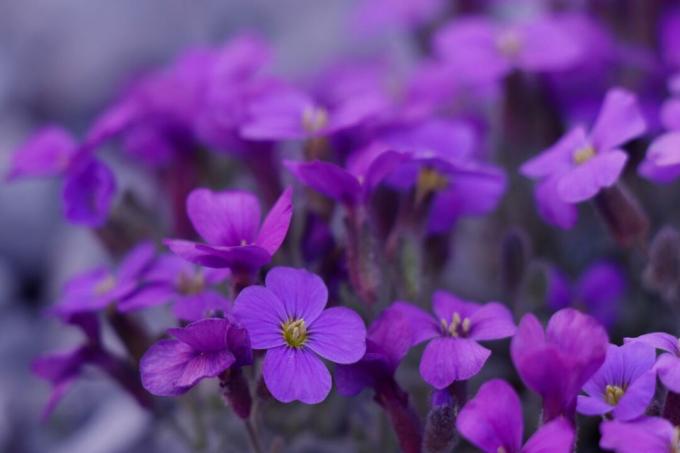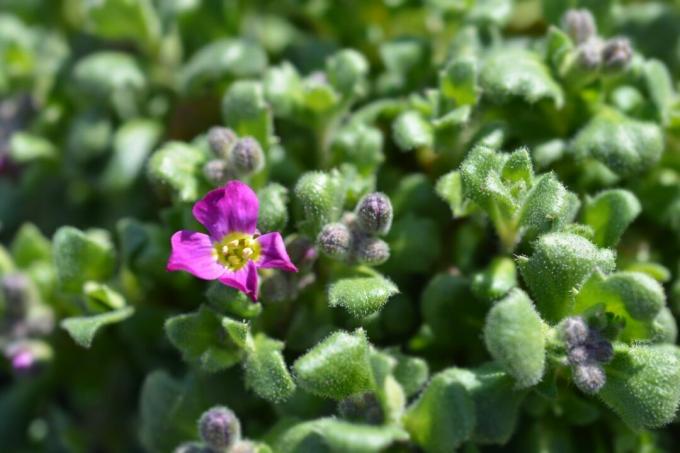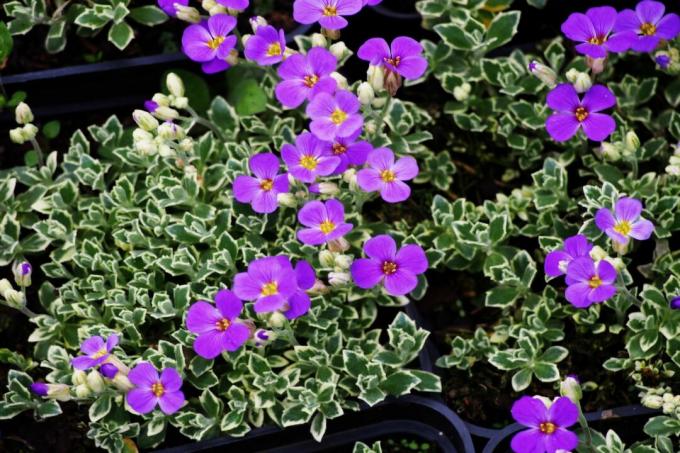The blue cushion covers the rock garden like a soft carpet or hangs down from flower boxes on the balcony. The cushion perennial is not only appreciated for its ornamental value, but also for its undemanding nature.

The Blue Pillow (Aubrieta) makes even the barren dry stone wall shine. With its bluish-purple flowers, it is a welcome ornament in the garden and even a nectar-giving bee pasture. In this article we explain all the information about planting, care and the most beautiful varieties of Aubrietie.
Contents
-
Blue cushion: origin and properties
- When do blue cushions bloom?
- Are blue cushions perennial?
-
The most beautiful types and varieties: Greek blue cushion & Co.
- Varieties of culture blue pillows
- Other decorative Aubrieta species
- Plant blue cushions
- The right care
- Are blue cushions hardy?
- propagation
- Are blue cushions poisonous?
Blue cushion: origin and properties
The blue cushion is also called Aubrietie and includes the genus of plants
Aubrieta, which belongs to the cruciferous family (Brassicaceae). The genus includes about 15 species that were originally distributed in the Mediterranean region and in the Near East. In the meantime, the Aubrietia thrives well here in the right location. Most of the varieties and ornamental plants known to us are Aubrieta-Hybrids resulting from random crossings or deliberate breeding. Aubrietia are increasingly used in rockeries, as wall greening or as a hanging ornament in balcony boxes. Used as ground cover, blue cushions are creeping, low-growing cushion perennials, reaching a maximum height of 15 cm. With their growth form, they form wide and dense mats with which they cover barren surfaces in the garden. Depending on the species, their evergreen and small leaves are lanceolate to spatulate, undivided, toothed or entire with a light green colour. Between April and May, Aubrietia produce numerous flowers, which then develop into egg-shaped pods. Depending on the variety, the color spectrum of the small cruciferous flowers varies from white, blue, violet, to pink and red. Aubrietia are also considered to be extremely insect-friendly. With its blooms, the blue cushion offers bees, various butterflies and numerous other pollinators a rich source of nectar.
When do blue cushions bloom?
Most blue cushions have a flowering period from April to May. Because the buds grow densely packed, together they form a homogeneous bud cluster.
Are blue cushions perennial?
The blue cushion is a perennial plant. If the Aubrietie grows in the right place and does not get too much moisture there, it can beautify the garden for several years. In unfavorable, too damp and too cold locations, it sometimes freezes to death in winter.

The most beautiful types and varieties: Greek blue cushion & Co.
Many popular varieties of the blue cushion are hybrids of different ones Aubrieta-Species that are also increasingly used in our home gardens. They can be recognized by the designation “x cultorum”. Depending on the breed, the blue cushion varies in color in particular. Here we present the most beautiful varieties and types:
Varieties of culture blue pillows
- blue pillow Aubrieta x cultorum 'blue tit': growth height between 8 and 10 cm; blue-violet flowers from April to May; hardy to -23 °C.

- blue pillow Aubrieta x cultorum 'Cascade Blue': growth height of 8 – 10 cm; bright blue flowers from April to May; hardy down to -29 °C.

- blue pillow Aubrieta x cultorum 'Cascade Red': growth height between 8 and 10 cm; red bloom between April and May; hardy to -20 °C.

- blue pillow Aubrieta x cultorum 'Huerth': growth height between 5 and 10 cm; light blue flowers from April to May and second flowering period in September; hardy to −23 °C; Special feature: Reliable formation of a second pile by pruning after flowering, i.e. replanting behavior.
- blue pillow Aubrieta x cultorum ‘Winterling’: growth height between 5 and 10 cm; white, slightly double flowers between April and May; hardy down to -23 °C.
- blue pillow Aubrieta x cultorum 'Downer's Bont': White variegated variety with white border on the leaves; Dark purple flowers, hardy to -23 °C.

Tip: The Aubrieta-Variety 'Pixie Pearls' also has white flowers, but the flowers are single and therefore more conducive to bees and other insects.

More decorative Aubrieta-Species
- blue pillow Aubrieta gracilis: growth height up to 10 cm; blue-violet flower; flowering time from March to May; Hairiness on leaves and stems.

- Greek blue pillow Aubrieta deltoidea: growth height of 5 – 20 cm; purple, pink, red, or white bloom; long flowering period from April to June.

- Star-haired blue pillow Aubrieta columnae: growth height between 5 and 10 cm; pink to blue-violet flowers between April and May; slightly hairy leaves and stems.

Plant blue cushions
As a densely growing ground cover, blue cushions can form magnificent carpets of flowers. In this way, even a single specimen develops into a dense, flowering cushion. Several blue cushions can be placed in groups and decorate beds or pots for a sprawling bloom. In addition, the easy-care blue cushion can be used for grave planting, where it adorns the ground as an evergreen plant even in winter. The Aubrietie is quite undemanding in terms of soil conditions. Blue cushions are best planted on moderately dry to fresh soil and not on summer-dry soil - this is where they thrive best. The subsoil should not accumulate moisture, be rich in nutrients and not too poor in lime. A sunny to full sun and, above all, warm location should be chosen.
All in all, the living areas rocky steppe, stone complex and wall crown, each with sufficient water supply, are perfectly suited for the warmth-loving Aubrietie. The stones store heat and thus create optimal conditions.
Blue cushions are best planted in spring from March or October and proceed as follows:
- Dig a hole for planting, twice the volume of the seed pot.
- If necessary, fill in a drainage layer.
- Wet the root ball of the Aubrietia and place it in the hole.
- Fill the cavities with excavation and press down lightly.
- Water the plant with about 2-3 liters of water.
If you want to plant several specimens next to each other, they should be placed in such a way that a planting distance of at least half the growth width is maintained. Therefore, no more than 10 perennials should be planted on one square meter.

If you don't have a garden or want to beautify your balcony, you can also cultivate your blue cushion outside in a pot. Ours, for example, is suitable for pot culture Plantura organic compost. This peat-free and long-term pre-fertilized substrate provides your Aubrietia with sufficient nutrients and thus promotes growth and flowering of the perennial. Since the plant does not tolerate waterlogging, sufficient drainage should be ensured for a pot culture. It is therefore advisable to cover the base of the pot with a layer of gravel and to thin the substrate used with 30% sand. A container with a diameter of at least 40 cm should be chosen for the blue cushion in the bucket so that the plant has plenty of space to grow. When planting in the pot, the same procedure is used as for the bed planting mentioned above.

organic compost
- Ideal for all ornamental and useful plants with a high nutrient requirement and for raised beds
- For improved soil quality & healthy root growth
- Peat-free & climate-friendly: CO2-reduced organic soil made in Germany
Tip: The blue cushion can be easily combined with various flowering perennials. So it forms with neighbors like the goose cress (Arabis spec.), the candytuft (iberis spec.) or the alyssum (Alyssum spec.) a colorful carpet of flowers.
The right care
As a frugal perennial, the blue cushion requires little care. To keep the cushion perennial nice and compact, it is advisable to cut the Aubrietia back by about half every year after flowering in May. This prevents seed formation and compacts the cushion. Also, pruning after flowering allows reblooming strains to flower again. The blue cushion should only be fertilized in spring, because late fertilization reduces its winter hardiness. It is enough to lay out a light layer of compost in the spring, which will promote growth and flowering of the perennial. A granulated slow-release fertilizer like ours is easier to distribute Plantura organic flower fertilizer. This predominantly organic flower fertilizer provides your Aubrietie with long-term nutrients. Fertilize before flowering in February or after flowering, at the end of May.

In addition, constant watering should not be forgotten. Although the blue cushion tolerates drought, it should be watered regularly. Especially during the hot summer months you should use the pot more often and keep the soil moderately moist.
Are blue cushions hardy?
Although the perennial comes from warmer regions, the blue cushion is quite hardy. Depending on the variety, it tolerates temperatures of a maximum of -29 °C outdoors and does not require any protection. If the blue cushion grows in the pot or if the outside temperature continues to drop, the bottom can be covered with brushwood and the bucket wrapped with a suitable fleece. During the winter, the Aubrietie is most sensitive to waterlogging. To prevent root rot, choose a container with adequate drainage and place it under a sheltered canopy.

propagation
Blue cushions are propagated in many ways. So you can sow seeds in spring with bought seeds or your own seeds. Dividing the blue cushion's root ball after flowering proves more difficult and is therefore not a common practice. The easiest way to propagate Aubrietia by cuttings at the end of May is as follows:
- When pruning at the end of May, cut off about 7 cm of the shoots
- Put the cuttings in small pots filled with potting soil like ours Plantura Organic Herb & Seed Soil mixed with 20% sand
- Water the substrate and place the pots in a bright place
- Allow to root at 20 °C for 3 – 4 weeks
- Always keep the substrate moist, but do not let it get waterlogged
- Repot young plants as soon as roots have formed

Are blue cushions poisonous?
Blue cushions are non-toxic and can be touched by humans, dogs and cats without hesitation. However, consumption is not recommended as it is not known how the digestion of all mammals reacts to the plant juices.
Barren rock gardens and walls can be enlivened with blue cushions and all kinds of fragrant herbs. Slightly higher, drier and less nutritious all in one herbal spiral planted it thrives Greek mountain tea, which not only looks fascinating, but also tastes good.
Register now for the Garten-Post and receive great tips, seasonal trends and inspiration on everything to do with the garden from our expert every week.
